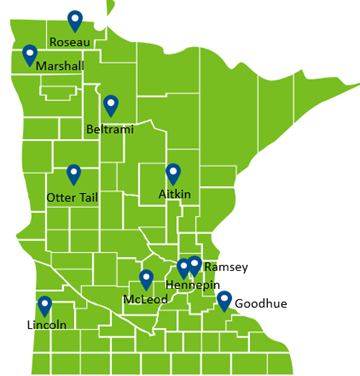Walkable Community Workshops
Communities are increasing support for walking
 Across the state, momentum is building around support for walking – your community can be part of this momentum.
Across the state, momentum is building around support for walking – your community can be part of this momentum.
Walkable communities = healthy, thriving communities
Walkable communities make it easier for people to be physically active, foster social connections and improve access to everyday destinations. In short, walkable communities are healthy, thriving communities.
Thanks to a grant from the Centers for Disease Control and Prevention, MDH made available up to $5,000 to communities to support implementation priorities identified during the workshop. These half-day workshops, facilitated by MDH staff, brought together community members and those who have influence over community walking conditions. At the workshop, participants built a strategy to improve walkability within their unique local context. After the workshop, local communities received ongoing technical assistance from MDH to implement their action plans.
Current workshop results
Host communities are building upon and benefitting from WCW results in many ways:
- Aitkin County: A committed group of stakeholders will implement a demonstration project to improve walking conditions along a major highway. Aitkin's Walkable Community Workshop (PDF)
- Beltrami County (Bemidji): Based on the WCW, investments will be made in walking infrastructure along priority routes that connect to key destinations. Bemidji's Walkable Community Workshop (PDF)
- Goodhue County (Red Wing): Increased lighting will create feelings of security and improve visibility near street crossings.
- Hennepin County (Minneapolis, Glendale Homes): Working with the Public Housing Authority, the city installed temporary curb extensions at key crosswalks.
- Lincoln County (Tyler): A Safe Walkable Tyler began with the Safe Routes to School (SRTS) program.
- Marshall (Warren): Building on previous grants and progress, the community secured an infrastructure grant to install new sidewalks, crosswalk, and ADA ramps from the school campus to a main street entrance.
- McLeod County (Glencoe): A group of physically active community leaders called Glencoe in Motion implemented a demonstration trail along Hennepin Ave and community feedback will refine next steps. Glencoe's Walkable Community Workshop (PDF)
- Otter Tail County (Fergus Falls): The community completed a Fergus Falls Bicycle and Pedestrian Master plan, the first pedestrian and bike plan for the city which will now be implemented.
- Ramsey County (St Paul, McDonough Homes): A public housing authority WCW led to an enhanced crosswalk demonstration project and the installation of benches along a popular walking route. The public housing residents continue to engage with city staff on pedestrian issues.
- Roseau County: Roseau installed wayfinding signage along their local trail and sidewalk system and utilized a Bicycle Friendly Community Program assessment to implement other strategies.
Questions?
MDH has tools and resources you need to take the first step.
Contact the Active Living team at health.activeliving@state.mn.us.